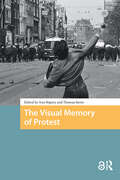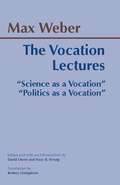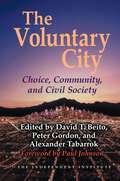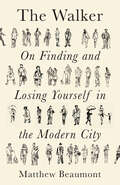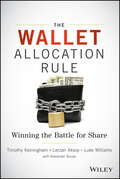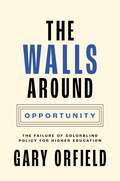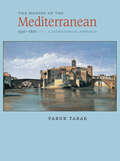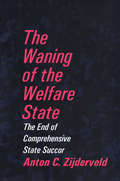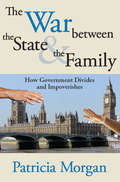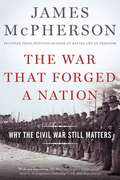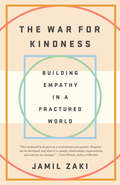- Table View
- List View
The Visual Memory of Protest (Protest and Social Movements)
by Ann Rigney Thomas SmitsSocial movements are not only remembered in personal experience, but also through cultural carriers that shape how later movements see themselves and are seen by others. The present collection zooms in on the role of photography in this memory-activism nexus. How do iconographic conventions shape images of protest? Why do some images keep movements in the public eye, while others are quickly forgotten? What role do images play in linking different protests, movements, and generations of activists? Have the affordances of digital media made it easier for activists to use images in their memory politics, or has the digital production and massive online exchange of images made it harder to identify and remember a movement via a single powerful image? Bringing together experts in visual culture, cultural memory, social movements, and digital humanities, this collection presents new empirical, theoretical, and methodological insights into the visual memory of protest.
The Visualised Foetus: A Cultural and Political Analysis of Ultrasound Imagery (Theory, Technology And Society Ser.)
by Julie RobertsThe latest three- and four dimensional images produced by modern ultrasound technology offer strikingly realistic representations of the foetus - representations that have further transformed experiences of pregnancy, the public understanding of foetal existence and the rhetoric of the abortion debate. Presenting a timely feminist engagement with this new technology, The Visualised Foetus explores the widespread familiarity with and popularity of this new technology within the context of a longer history of foetal visualisations. The book offers an array of case studies that examine the diffusion of 3/4D ultrasound images beyond the clinic and the implications of this new technology for biopolitics in the European and American context. With attention to the non-diagnostic and commercial use of 3/4D images, the impact of 3/4D ultrasound within the abortion debate, and new claims that ultrasound aids maternal-foetal bonding, The Visualised Foetus demonstrates the tension between the social and medical significances of foetal ultrasound, the pleasures and dangers of foetal imagery for women, the contested status of ultrasonography as 'scientific' imagery, and struggles over the authority to define and interpret ultrasound imagery. As such, it will appeal to scholars of the sociology of medicine and the body, social theory and gender and cultural studies, as well as those with interest in science and technology studies.
The Vital Illusion (The Wellek Library Lectures)
by Jean BaudrillardAren't we actually sick of sex, of difference, of emancipation, of culture? With this provocative taunt, the indomitable sociologist Jean Baudrillard challenges us to face up to our deadly, technologically empowered renunciation of mortality and subjectivity as he grapples with the complex issues that define our postmillennial world. What does the advent and proliferation of cloning mean for our sense of ourselves as human beings? What does the turn of the millennium say about our relation to time and history? What does the instantaneous, virtual realm of cyberspace do to reality? In The Vital Illusion—as always—Baudrillard leads his readers to some surprising conclusions.Baudrillard considers how human cloning—as well as the "cloning" of ideas and social identities—heralds an end to sex and death and the divagations of living by instituting a realm of the Same, beyond the struggles of individuation. In this day and age when everything can be cloned, simulated, programmed, and genetically and neurologically managed, humanity shows itself unable to brave its own diversity, preferring instead to regress to the pathological eternity of self-replicating cells. By reverting to our viral origins as sexless immortal beings, we are, ironically, fulfilling a death wish, putting an end to our own species as we know it. Next, Baudrillard explores the "nonevent" that was and is the turn of the millennium. He provocatively puts forward the thesis that the arrival of the year 2000 could never take place because we could neither resolve nor leave behind our history, nor could we stop counting down toward our future. For Baudrillard, the millennial clock reading to the millionth of a second on its way to zero is the perfect symbol of our time: history decays rather than progresses. In closing, Baudrillard examines what he calls "the murder of the real" by the virtual. In a world of copies and clones in which everything can be made present in an instant by technology, we can no longer even speak of reality. Beyond Nietzsche's symbolic murder of God, our virtual world free of referents is in the process of exterminating reality, leaving no trace: "The corps(e) of the Real—if there is any—has not been recovered, is nowhere to be found."Peppered with Baudrillard's signature counterintuitive moves, prophetic visions, and dark humor, The Vital Illusion exposes the contradictions that guide our contemporary culture and rule our lives.
The Vitality of Taiwan
by Steve TsangAs a country, Taiwan is one of the most vibrant, exciting, colourful and entrepreneurial on earth. The contributors reveal what underpins the vitality of Taiwan, examining the relevance of its democratic politics, civil society and the presence of an existential threat from China, as well as the importance of its international business nexus.
The Vocation Lectures
by Max Weber David Owen Tracy B. Strong Rodney LivingstoneOriginally published separately, Weber's Science as a Vocation and Politics as a Vocation stand as the classic formulations of his positions on two related subjects that go to the heart of his thought: the nature and status of science and its claims to authority; and the nature and status of political claims and the ultimate justification for such claims. Together in this volume, these newly translated lectures offer an ideal point of entry into Weber's central project: understanding how, as Weber put it, "in the West alone there have appeared cultural manifestations [that seem to] go in the direction of universal significance and validity.
The Voice of Music: Conversations with Composers of Our Time
by Anders BeyerThis title was first published in 2000. Extensive and generously illustrated interviews have been a feature of the lively Danish music periodical "Dansk Musik Tidsskrift" (Danish Music Review) since the 1960s. Now a long-standing tradition, these "conversations" with influential composers from all over the world are prepared by professional musicians and experienced writers on music. This volume is a collection of interviews selected from issues published since 1990 by Anders Beyer, the journal's editor-in-chief. The book gives an up-to-date picture of the North European musical perspectives through interviews with composers from each of the Nordic countries. These are further complemented by interviews with trend-setting composers from the rest of Europe and America. The interviews have been edited and translated into English to make them accessible to a wider audience. The volume features interviews with composers including Erik Bergman, Tikhon Chrennikov, Edison Denisov, Hans Gerfors, Philip Glass, Sofia Gubaidulina and Pelle Gudmundsen-Holmgreen.
The Voltage Effect: How to Make Good Ideas Great and Great Ideas Scale
by John A. ListA leading economist answers one of today&’s trickiest questions: Why do some great ideas make it big while others fail to take off? &“Brilliant, practical, and grounded in the very latest research, this is by far the best book I&’ve ever read on the how and why of scaling.&”—Angela Duckworth, CEO of Character Lab and New York Times bestselling author of GritONE OF THE MOST ANTICIPATED BOOKS OF 2022—Men&’s Journal&“Scale&” has become a favored buzzword in the startup world. But scale isn't just about accumulating more users or capturing more market share. It's about whether an idea that takes hold in a small group can do the same in a much larger one—whether you&’re growing a small business, rolling out a diversity and inclusion program, or delivering billions of doses of a vaccine. Translating an idea into widespread impact, says University of Chicago economist John A. List, depends on one thing only: whether it can achieve &“high voltage&”—the ability to be replicated at scale. In The Voltage Effect, List explains that scalable ideas share a common set of attributes, while any number of attributes can doom an unscalable idea. Drawing on his original research, as well as fascinating examples from the realms of business, policymaking, education, and public health, he identifies five measurable vital signs that a scalable idea must possess, and offers proven strategies for avoiding voltage drops and engineering voltage gains. You&’ll learn: • How celebrity chef Jamie Oliver expanded his restaurant empire by focusing on scalable &“ingredients&” (until it collapsed because talent doesn&’t scale) • Why the failure to detect false positives early on caused the Reagan-era drug-prevention program to backfire at scale • How governments could deliver more services to more citizens if they focused on the last dollar spent • How one education center leveraged positive spillovers to narrow the achievement gap across the entire community • Why the right set of incentives, applied at scale, can boost voter turnout, increase clean energy use, encourage patients to consistently take their prescribed medication, and more. By understanding the science of scaling, we can drive change in our schools, workplaces, communities, and society at large. Because a better world can only be built at scale.
The Voluntary City: Choice, Community, and Civil Society
by David T. Beito, Peter Gordon and Alexander TabarrokAssembling a rich history and analysis of large-scale, private and voluntary, community-based provision of social services, urban infrastructure, and community governance, this book provides suggestions on how to restore the vitality of city life.Historically, the city was considered a center of commerce, knowledge and culture, a haven for safety and a place of opportunity. Today, however, cities are widely viewed as centers for crime, homelessness, poverty, unemployment, traffic, pollution, and other social ills. In many cities, government increasingly dominates life, consuming vast resources to cater to special interest groups. Decision-making has become intensely politicized, bureaucratic, and largely unaccountable to the populace. The Voluntary City provides a rich history and analysis of private, locally based provision of social services, urban infrastructure, and community governance. Such systems have offered superior education, transportation, housing, crime control, recreation, health care, and employment by being more effective, innovative, and responsive than those provided through special interest politics and bureaucracy. The Voluntary City reveals how the process of providing local public goods through the dynamism of freely competitive, market-based entrepreneurship is unmatched in renewing communities and strengthening the bonds of civil society. A refreshing challenge to the orthodoxy that government alone can improve community life, The Voluntary City will be an essential reference for anyone interested in the future of cities, including scholars and students, policy-makers, civic and business leaders, and urban citizens.
The Voucher Promise: "Section 8" and the Fate of an American Neighborhood
by Eva RosenAn in-depth look at America’s largest rental assistance program and how it shapes the lives of residents in one low-income Baltimore neighborhoodHousing vouchers are a cornerstone of US federal housing policy, offering aid to more than two million households. Vouchers are meant to provide the poor with increased choice in the private rental marketplace, enabling access to safe neighborhoods with good schools and higher-paying jobs. But do they?The Voucher Promise examines the Housing Choice Voucher Program, colloquially known as “Section 8,” and how it shapes the lives of families living in a Baltimore neighborhood called Park Heights. Eva Rosen tells stories about the daily lives of homeowners, voucher holders, renters who receive no housing assistance, and the landlords who provide housing. While vouchers are a powerful tool with great promise, she demonstrates how the housing policy can replicate the very inequalities it has the power to solve.Rosen spent more than a year living in Park Heights, sitting on front stoops, getting to know families, accompanying them on housing searches, speaking to landlords, and learning about the neighborhood’s history. Voucher holders disproportionately end up in this area despite rampant unemployment, drugs, crime, and abandoned housing. Exploring why they are unable to relocate to other neighborhoods, Rosen illustrates the challenges in obtaining vouchers and the difficulties faced by recipients in using them when and where they want to. Yet, despite the program’s real shortcomings, she argues that vouchers offer basic stability for families and should remain integral to solutions for the nation’s housing crisis.Delving into the connections between safe, affordable housing and social mobility, The Voucher Promise investigates the profound benefits and formidable obstacles involved in housing America’s poor.
The Vulnerable Andaman and Nicobar Islands: A Study of Disasters and Response
by Poonam TripathiThis first full-length book addresses disasters in the context of vulnerability of the Andaman and Nicobar Islands that comprise 572 islands in the Bay of Bengal. It looks at the disasters that the islands have experienced in the last 200 years and analyzes major disasters since colonization by the British. Raising some critical questions, this book attempts to understand the overall profile of disasters – the facts, causes, damage, response and recovery – in the Andaman and Nicobar Islands. It discusses earthquakes, cyclones, tsunami and epidemics, as well as impacts of World War II, the penal colony and the post-Independence resettlement on the tribal population. The work will serve as a rich resource with its detailed tables, figures, maps and diagrams; appendices; and database ranging from travelogues, Census of India reports and fieldwork to Right to Information (RTI) petitions that collect hitherto unknown facts. The book will be useful to students of geography, disasters and disasters management, climate and environmental studies, history, sociology, island and ocean studies, and South Asian studies.
The Wages of War: When America's Soldiers Came Home: From Valley Forge to Vietnam (Forbidden Bookshelf #20)
by Richard Severo Lewis MilfordA disturbing chronicle of the US government&’s mistreatment of American soldiers and veterans throughout history, with a new introduction by Charles Sheehan-Miles Time and time again, the sacrifices made by veterans and their families have been repaid with scorn, discrimination, lack of health services, scant financial compensation, and other indignities. This injustice dates back as far as the American Revolution, when troops came home penniless and without prospects for work, yet had to wait decades before the government paid them the wages they were owed. When soldiers returned from the Cuban campaign after the Spanish-American War, they were riddled with malaria, typhoid, yellow fever, and dysentery—but the government refused to acknowledge their illnesses, and finally dumped them in a makeshift tent city on Long Island, where they were left to starve and die. Perhaps the most infamous case of disgraceful behavior toward veterans happened after the Vietnam War, when soldiers were forced to battle bureaucrats and lawyers, and suffer media slander, because they asked the government and chemical industry to help them cope with the toxic aftereffects of Agent Orange. In The Wages of War, authors Richard Severo and Lewis Milford not only uncover new information about the controversial use of this defoliant in Vietnam and the subsequent class action suit brought against its manufacturers, but also present fresh information on every war in US history. The result is exhaustive proof that—save for the treatment of soldiers in the aftermath of World War II—the government&’s behavior towards American servicemen has been more like that of &“a slippery insurance company than a policy rooted in the idea of justice and fair reward.&”
The Wagon and Other Stories from the City
by Martin PreibMartin Preib is an officer in the Chicago Police Department--a beat cop whose first assignment as a rookie policeman was working on the wagon that picks up the dead. Over the course of countless hours driving the wagon through the city streets, claiming corpses and taking them to the morgue, arresting drunks and criminals and hauling them to jail, Preib took pen to paper to record his experiences. Inspired by Preib's daily life as a policeman, The Wagon and Other Stories from the City chronicles the outer and inner lives of both a Chicago cop and the city itself. The book follows Preib as he transports body bags, forges an unlikely connection with his female partner, trains a younger officer, and finds himself among people long forgotten--or rendered invisible--by the rest of society. Preib recounts how he navigates the tenuous labyrinths of race and class in the urban metropolis, such as a domestic disturbance call involving a gang member and his abused girlfriend or a run-in with a group of drunk yuppies. As he encounters the real and imagined geographies of Chicago, the city reveals itself to be not just a backdrop, but a central force in his narrative of life and death. Preib's accounts, all told in his breathtaking prose, range from noir-like reports of police work to streetwise meditations on life and darkly humorous accounts of other jobs in the city's service industry. Here, Preib's universe of police officers, criminals, and victims--and everyone in between--comes alive in ways that readers will long remember.
The Walker: On Losing and Finding Yourself in the Modern City
by Matthew BeaumontA literary history of walking From Dickens to ZizekThere is no such thing as the wrong step; every time we walk we are going somewhere. Moving around the modern city becomes more than from getting from A to B, but a way of understanding who and where you are. In a series of riveting intellectual rambles, Matthew Beaumont, retraces a history of the walker.From Charles Dicken's insomniac night rambles to wandering through the faceless, windswept monuments of the neoliberal city, the act of walking is one of escape, self-discovery, disappearances and potential revolution. Pacing stride for stride alongside such literary amblers and thinkers as Edgar Allen Poe, Andrew Breton, H G Wells, Virginia Woolf, Jean Rhys and Ray Bradbury, Matthew Beaumont explores the relationship between the metropolis and its pedestrian life. He asks can you get lost in a crowd? It is polite to stare at people walking past on the street? What differentiates the city of daylight and the nocturnal metropolis? What connects walking, philosophy and the big toe? Can we save the city - or ourselves - by taking the pavement?
The Wallet Allocation Rule
by Luke Williams Lerzan Aksoy Timothy L. Keiningham Alexander J. BuoyeCustomer Loyalty Isn't Enough--Grow Your Share ofWallet The Wallet Allocation Rule is a revolutionary, definitiveguide for winning the battle for share of customers' hearts, minds,and wallets. Backed by rock-solid science published in theHarvard Business Review and MIT Sloan ManagementReview, this landmark book introduces a new and rigorouslytested approach--the Wallet Allocation Rule--that isproven to link to the most important measure of customer loyalty:share of wallet.Companies currently spend billions of dollars each yearmeasuring and managing metrics like customer satisfaction and NetPromoter Score (NPS) to improve customer loyalty. These metrics,however, have almost no correlation to share of wallet. As aresult, the returns on investments designed to improve the customerexperience are frequently near zero, even negative.With The Wallet Allocation Rule, managers finally havethe missing link to business growth within their grasp--theability to link their existing metrics to the share of spendingthat customers allocate to their brands.Learn why improving satisfaction (or NPS) does not improveshare.Apply the Wallet Allocation Rule to discover what really drivescustomer spending.Uncover new metrics that really matter to achieve growth.By applying the Wallet Allocation Rule, managers get realinsight into the money they currently get from their customers, themoney available to be earned by them, and what it takes to get it.The Wallet Allocation Rule provides managers with ablueprint for sustainable long-term growth.
The Walls around Opportunity: The Failure of Colorblind Policy for Higher Education (Our Compelling Interests #6)
by Gary OrfieldThe case for race-conscious education policyIn our unequal society, families of color fully share the dream of college but their children often attend schools that do not prepare them, and the higher education system gives the best opportunities to the most privileged. Students of color hope for college but often face a dead end.For many young people, racial inequality puts them at a disadvantage from early childhood. The Walls around Opportunity argues that colorblind policies have made college inaccessible to a large share of students of color, and reveals how policies that acknowledge racial inequalities and set racial equality goals can succeed where colorblindness has failed.Gary Orfield paints a troubling portrait of American higher education, explaining how profound racial gaps imbedded in virtually every stage of our children’s lives pose a major threat to communities of color and the nation. He describes how the 1960s and early 1970s was the only period in history to witness sustained efforts at racial equity in higher education, and how the Reagan era ushered in today’s colorblind policies, which ignore the realities of color inequality. Orfield shows how this misguided policy has resegregated public schools, exacerbated inequalities in college preparation, denied needed financial aid to families, and led to huge price increases over decades that have seen little real gain in income for most Americans.Drawing on a wealth of new data and featuring commentaries by Stella Flores and James Anderson, this timely and urgent book shows how colorblind policies serve only to raise the walls of segregation higher, and proposes real solutions that can make higher education available to all.
The Walls around Opportunity: The Failure of Colorblind Policy for Higher Education (Our Compelling Interests #8)
by Gary OrfieldThe case for race-conscious education policyIn our unequal society, families of color fully share the dream of college but their children often attend schools that do not prepare them, and the higher education system gives the best opportunities to the most privileged. Students of color hope for college but often face a dead end.For many young people, racial inequality puts them at a disadvantage from early childhood. The Walls around Opportunity argues that colorblind policies have made college inaccessible to a large share of students of color, and reveals how policies that acknowledge racial inequalities and set racial equality goals can succeed where colorblindness has failed.Gary Orfield paints a troubling portrait of American higher education, explaining how profound racial gaps imbedded in virtually every stage of our children&’s lives pose a major threat to communities of color and the nation. He describes how the 1960s and early 1970s was the only period in history to witness sustained efforts at racial equity in higher education, and how the Reagan era ushered in today&’s colorblind policies, which ignore the realities of color inequality. Orfield shows how this misguided policy has resegregated public schools, exacerbated inequalities in college preparation, denied needed financial aid to families, and led to huge price increases over decades that have seen little real gain in income for most Americans.Now with a new afterword that discusses the 2023 Supreme Court decision to outlaw affirmative action in college admissions, this timely and urgent book shows that the court&’s colorblind ruling is unworkable in a society where every aspect of opportunity and preparation is linked to race, and reveals the gaps in the opportunity pipeline while exploring the best ways to address them in light of this decision.
The Wanano Indians of the Brazilian Amazon: A Sense of Space
by Janet M. ChernelaThe Wanano Indians of the northwest Amazon have a social system that differs from those of most tropical forest tribes. Neither stratified by wealth nor strictly egalitarian, Wanano society is "ranked" according to rigidly bound descent groups. In this pioneering ethnographic study, Janet M. Chernela decodes the structure of Wanano society.<P><P>In Wanano culture, children can be "grandparents," while elders can be "grandchildren." This apparent contradiction springs from the fact that descent from ranked ancestors, rather than age or accumulated wealth, determines one's standing in Wanano society. But ranking's impulse is muted as senior clans, considered to be succulent (referring to both seniority and resource abundance), must be generous gift-givers. In this way, resources are distributed throughout the society.
The Waning of the Mediterranean, 1550–1870: A Geohistorical Approach
by Faruk Tabak2008 Outstanding Academic Title, Choice MagazineConventional scholarship on the Mediterranean portrays the Inner Sea as a timeless entity with unchanging ecological and agrarian features. But, Faruk Tabak argues, some of the "traditional" and "olden" characteristics that we attribute to it today are actually products of relatively recent developments. Locating the shifting fortunes of Mediterranean city-states and empires in patterns of long-term economic and ecological change, this study shows how the quintessential properties of the basin—the trinity of cereals, tree crops, and small livestock—were reestablished as the Mediterranean's importance in global commerce, agriculture, and politics waned.Tabak narrates this history not from the vantage point of colossal empires, but from that of the mercantile republics that played a pivotal role as empire-building city-states. His unique juxtaposition of analyses of world economic developments that flowed from the decline of these city-states and the ecological change associated with the Little Ice Age depicts large-scale, long-term social change. Integrating the story of the western and eastern Mediterranean—from Genoa and the Habsburg empire to Venice and the Ottoman and Byzantine empires—Tabak unveils the complex process of devolution and regeneration that brought about the eclipse of the Mediterranean.
The Waning of the Welfare State
by Anton ZijderveldThe welfare state in postwar Western Europe has been extended and intensified in a spectacular manner. Today, "welfare" represents a complex mix of services covering health, education, welfare, the arts, leisure, and social security. Anton C. Zijderveld is of the opinion that Europe's vast, comprehensive welfare state is becoming leaner and meaner, heading down a more sober path toward decentralization and deregulation, which only, but not merely, secures order for its citizens and shields society's vulnerable. As the millennium approaches, Zijderveld believes Europe is experiencing a cultural renaissance and a socioeconomic and political reformation in which the market will flourish and civil society will prosper.The Waning of the Welfare State focuses on the transformation of the welfare state in Europe over a four-decade period. Zijderveld employs the democratic triangle theoretical model, in which democracy is viewed as a system in which state, market, and civil society are held in precious balance. If one component supersedes the other two, democracy is endangered. In its 1960s and 1970s heyday, the state took center stage at the expense of the market and civil society; social democracy was the prevailing ideology. In the 1980s the market triumphed, often at the expense of both the state and civil society; this was the decade of liberalism. Today, civil society prevails, albeit at risk of being injurious to state and market. Ideologically, this is the decade of conservatism.Zijderveld sees a future "Americanization" of European social policy producing a fortuitously balanced coalition of social democracy, liberalism, and conservatism; a place where safety and order, prosperity and economic participation, and social participation and meaningful interactions flourish equally. This transformation carries many risks. But it will, in the end, strengthen Europe's political, economic, and sociocultural stamina. If it also draws the Atlantic partners closer together, as Zijderveld believes it does, the chances of another European communist, libertarian, or fascist Gtterdommerung will remain remote. Zijderveld presents useful concepts in a highly organized fashion. He has produced a very important book for American readers who will, hopefully, discover, beyond the often vast differences, some basic similarities of structures and developments within the European welfare state.
The War Against Nonhuman Animals: A Non-Speciesist Understanding of Gendered Reproductive Violence
by Stacy BanwellWe are currently engaged in an existential species war against nonhuman animals. This book argues that, during this war, nonhuman animals should be granted legal personhood and treated as ‘protected persons’ rather than the property of ‘protected persons.’ The main argument is that War Crimes and Crimes against Humanity – rape, forced pregnancy and other acts of sexual violence – are being committed within the meat, egg and dairy industries. Avoiding ‘dreaded comparisons’, the book explores shared sources of oppression between human and nonhuman animals who are subject to the expressions and consequences of reproductive violence. It asks: what drives and facilitates the war against nonhuman animals? And what are the global consequences of this war? Throughout, it demonstrates how racism, sexism, and speciesism informs both intrahuman violence and the violence(s) of the animal-industrial complex. Ultimately the book asks us to reconsider what it means to be human.
The War Against Parents
by Cornel West Sylvia Ann HewlettSylvia Ann Hewlett and Cornel West, a white woman and a black man, join to address the burning social issue of our time: the virtual abandonment of parents-poor and middle class-by America's business, political, and cultural elites. In what is both a visionary and intimate book, Hewlett and West present a blueprint for parent empowerment, which they call the Parents' Bill of Rights for the 21st century, which gives new value and dignity to the parental role and restores America's commitment to the well-being of children. With candor and hope for the future, the authors seek to unite America's 62 million parents behind an agenda that spans the divides of race, gender, and class.
The War Between the State and the Family: How Government Divides and Impoverishes
by Patricia MorganPatricia Morgan's core assumption is that the family is an extremely effective vehicle for raising the welfare of its members. If this is correct it is quite possible that the state can best support the family by doing very little--by not taxing the family heavily and by minimizing the subsidization of those who choose alternatives to financially self-sustaining family life.At one level, Morgan argues, the family can be seen as a unit within which there occurs enormous transfer of economic resources between husband and wife, parents and children, and, on a wider scale, within extended families. The family is the most important vehicle of welfare and the welfare vehicle of first resort. Within the family many services are provided by family members to each other, rarely for direct personal benefit. Basic economic analysis, Morgan asserts, suggests that the family could be seriously undermined if the state provided significant support for dependents who are not brought up within self-sustaining family units, and if it also provided services, such as childcare, that are generally provided within families. This work shows that this is precisely what has happened in the last twenty-five years.The driving force of significantly reduced family formation is not economic but social. Perhaps social changes have led to a desire by individuals to bring up children in family circumstances different from those of a generation or two ago, but evidence does not support this hypothesis. Rather, tax and benefit systems seem to be important determinants of family structure worldwide. Patricia Morgan does not simply analyze the problem, she also suggests policy solutions. The author argues that divorce laws should be reformed to ensure that those who make commitments are held financially responsible. The author's argument is compelling because it is backed up with strong evidence and is argued from an unemotional economic perspective--individuals within families are rational agents who respond to incentives.
The War For The the Heart & Soul of Highland Maya Town
by Robert S. CarlsenAfter a decade of military occupation known as la violencia, the Tz'utujil-speaking Maya of Santiago Atitlan stood up to the Guatemalan Army in 1990 and forced it to leave their town. Yet that act of solidarity did not close the widening internal divisions that threaten to destabilize the community from within. Ironically, after 500 years of resistance to physical and spiritual conquest, many Atitecos now seem eager to abandon traditional Mayan culture. In this compelling ethnography, Robert S. Carlsen explores the issue of cultural continuity and change as it has unfolded in this representative Mayan community. Drawing on documentary evidence, he argues that local Mayan culture survived the Spanish Conquest remarkably intact and continues to play a defining role in the religious and social life of the community. At the same time, however, he shows how the twentieth-century consolidation of the Guatemalan state has steadily eroded the capacity of Mayan communities to adapt to change and has caused some local factions to reject--even demonize--their own culture.
The War That Forged A Nation: Why The Civil War Still Matters
by James M. McPhersonMore than 140 years ago, Mark Twain observed that the Civil War had "uprooted institutions that were centuries old, changed the politics of a people, transformed the social life of half the country, and wrought so profoundly upon the entire national character that the influence cannot be measured short of two or three generations." In fact, five generations have passed, and Americans are still trying to measure the influence of the immense fratricidal conflict that nearly tore the nation apart. In The War that Forged a Nation, Pulitzer Prize-winning historian James M. McPherson considers why the Civil War remains so deeply embedded in our national psyche and identity. The drama and tragedy of the war, from its scope and size--an estimated death toll of 750,000, far more than the rest of the country's wars combined--to the nearly mythical individuals involved--Abraham Lincoln, Robert E. Lee, Stonewall Jackson--help explain why the Civil War remains a topic of interest. But the legacy of the war extends far beyond historical interest or scholarly attention. Here, McPherson draws upon his work over the past fifty years to illuminate the war's continuing resonance across many dimensions of American life. Touching upon themes that include the war's causes and consequences; the naval war; slavery and its abolition; and Lincoln as commander in chief, McPherson ultimately proves the impossibility of understanding the issues of our own time unless we first understand their roots in the era of the Civil War. From racial inequality and conflict between the North and South to questions of state sovereignty or the role of government in social change--these issues, McPherson shows, are as salient and controversial today as they were in the 1860s. Thoughtful, provocative, and authoritative, The War that Forged a Nation looks anew at the reasons America's civil war has remained a subject of intense interest for the past century and a half, affirms the enduring relevance of the conflict for America today.
The War for Kindness: Building Empathy in a Fractured World
by Jamil Zaki&“In this masterpiece, Jamil Zaki weaves together the very latest science with stories that will stay in your heart forever.&”—Angela Duckworth, author of GritDon&’t miss Jamil Zaki&’s TED Talk, &“We&’re experiencing an empathy shortage, but we can fix it together,&” online now. Empathy is in short supply. We struggle to understand people who aren&’t like us, but find it easy to hate them. Studies show that we are less caring than we were even thirty years ago. In 2006, Barack Obama said that the United States was suffering from an &“empathy deficit.&” Since then, things seem to have only gotten worse. It doesn&’t have to be this way. In this groundbreaking book, Jamil Zaki shares cutting-edge research, including experiments from his own lab, showing that empathy is not a fixed trait—something we&’re born with or not—but rather a skill that can be strengthened through effort. He also tells the stories of people who embody this new perspective, fighting for kindness in the most difficult of circumstances. We meet a former neo-Nazi who is now helping to extract people from hate groups, ex-prisoners discussing novels with the judge who sentenced them, Washington police officers changing their culture to decrease violence among their ranks, and NICU nurses fine-tuning their empathy so that they don&’t succumb to burnout. Written with clarity and passion, The War for Kindness is an inspiring call to action. The future may depend on whether we accept the challenge.Praise for The War for Kindness&“A wide-ranging practical guide to making the world better.&”—NPR&“Relating anecdotes and test cases from his fellow researchers, news events and the imaginary world of literature and entertainment, Zaki makes a vital case for &‘fighting for kindness.&’ . . . If he&’s right—and after reading The War for Kindness, you&’ll probably think so—Zaki&’s work is right on time.&” —San Francisco Chronicle&“In this landmark book, Jamil Zaki gives us a revolutionary perspective on empathy: Empathy can be developed, and, when it is, people, relationships, organizations, and cultures are changed.&”—Carol Dweck, author of Mindset
